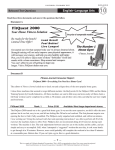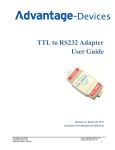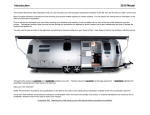Download PCAN-B10011S User Manual
Transcript
PCAN-B10011S Converter High-speed CAN to Truck Trailer CAN User Manual PCAN-B10011S - User Manual Products taken into account Product Name Model PCAN-B10011S Item Number IPEH-002041 Last Updates March 23, 2005 First edition February 24, 2006 Minor text corrections Added technical specifications All product names mentioned herein may be the trademarks or registered trademarks of their respective companies. Furthermore, "™" and "®" are not mentioned in each case in this manual. © 2006 PEAK-System Technik GmbH PEAK-System Technik GmbH Otto-Röhm-Straße 69 D-64293 Darmstadt, Germany Phone: +49 (0)6151-8173-20 Fax: +49 (0)6151-8173-29 www.peak-system.com [email protected] 2 PCAN-B10011S - User Manual Contents 1 1.1 1.2 1.3 2 2.1 2.2 2.3 3 3.1 3.2 3.3 4 4.1 4.2 4.3 Introduction 5 Properties at a Glance System Requirements Scope of Supply Installation 5 6 6 7 Connecting the High-speed CAN Side Connecting the Truck Trailer CAN Side Power Supply Operation 7 8 8 10 Transfer Rate Active/Passive Operation Master/Slave Communication Problems 10 10 11 12 Red LED "Error" Adjusting the Internal System Voltage Single-Wire Operation Modes 12 13 14 5 Frequently Asked Questions (FAQ) 16 6 Technical Specifications 17 Appendix A A.1 Certificates 18 CE Appendix B 18 Quick Reference 3 19 PCAN-B10011S - User Manual Converter Elements Low voltage connector socket (page 8) Termination HS-CAN (page 7) Connector HS-CAN (page 7) Error indicator (page 12) Internal system voltage (page 13) Master/Slave (page 11) Connector Truck Trailer CAN (page 8) Power indicator (page 8) Active/passive operation (page 10) 4 PCAN-B10011S - User Manual 1 Introduction Tip: At the end of this manual (Appendix B) you can find a Quick Reference with brief information about the installation and operation of the PCAN-B10011S. The bus converter PCAN-B10011S establishes a connection between a High-speed CAN node and a Truck Trailer CAN (ISO 11992-1). The Truck Trailer CAN is, as the name already implies, a communication link between a truck and its trailer. The bus converter makes this communication accessible for the commonly used High-speed CAN. The special conditions of this environment are taken into account, like long wires, high levels of disturbance, high voltage deviation, and a small amount of data. A Truck Trailer CAN consists of at least two nodes. The connection is done via a two-wire line. The power supply may be done locally or via the cable from the towcar, where the reference point is the local bodywork. Bodyworks from the towcar and the trailer are connected. Due to this configuration there are potential differences and disturbances the Truck Trailer CAN is optimized for. The transfer rate is significantly lower than in a High-speed CAN. The bus converter's design uses the CAN transceiver B10011S from Atmel. This is the reason for the bus converter's choice of name. 1.1 Properties at a Glance Direct connection to a HS-CAN component (Sub-D socket, 9 pins) Switchable termination for HS-CAN Connection of the Truck Trailer CAN via 9-pin Sub-D plug 5 PCAN-B10011S - User Manual Selection of the operation modes for the Truck Trailer CAN with slide switches Transfer rates up to 125 kBit/s Power supply via the Truck Trailer CAN bus or independently with an AC adaptor LEDs indicate existing power supply and errors 1.2 System Requirements The following prerequisites must be given, so that the PCANB10011S can be used properly: Existing power supply (usually 24 V DC) via Truck Trailer CAN bus (see section 2 Installation) – or – Possibility for supply with provided AC adaptor 1.3 Scope of Supply The scope of supply normally consists of the following parts: Bus converter module AC adaptor User manual 6 PCAN-B10011S - User Manual 2 2.1 Installation Connecting the High-speed CAN Side The PCAN-B10011S is designed for a direct connection to a HS-CAN component (PCAN-Dongle, for example). The HS-CAN side has a female Sub-D connector (9 pins) with a pin assignment according to CiA recommendation DS 102. Figure 1: Assignment of the HS-CAN connector Between CAN_L and CAN_H a switchable termination with a resistance of about 120 Ω is installed internally. Therefore an additional line termination is not needed for the connected HS-CAN component. If the PCAN-B10011S shall not be connected directly to a HS-CAN adapter and shall not become the endpoint of a HS-CAN bus, the termination can be set inoperable with the corresponding slide switch (see following figure and table). 7 PCAN-B10011S - User Manual HS-CAN-termination 120 Ω none 2.2 Switch position left right Connecting the Truck Trailer CAN Side For the connection of the Truck Trailer CAN bus a 9-pin male Sub-D port is used. The assignment is as follows: Figure 2: Assignment of the Truck Trailer CAN connector Optionally the power supply of the PCAN-B10011S can be done via pin 9 (see following section). 2.3 Power Supply The PCAN-B10011S can be supplied with power either via the Truck Trailer CAN bus (pin 9 "Battery") or independently via the lowvoltage connector (e.g. with an AC adaptor). In both cases a nominal DC voltage of 24 Volts should be available. 8 PCAN-B10011S - User Manual Figure 3: Assignment of the low-voltage connector socket Note: A simultaneous connection of both supply ways isn't problematic, because the power supply with the higher voltage (usually the one of the AC adaptor) is used automatically due to the circuit design. It is ensured that current cannot run from one power supply to the other. In principle higher or lower input voltages than 24 V may be applied (8 – 30 V). However, at high potential differences to system voltages of other Truck Trailer CAN nodes communication errors may occur. You can find hints for solving those problems in section 4.2 Adjusting the Internal System Voltage. The green LED at the housing of the PCAN-B10011S indicates an existing power supply. 9 PCAN-B10011S - User Manual 3 Operation When putting the PCAN-B10011S into operation please observe the following sections. 3.1 Transfer Rate For operating the PCAN-B10011S pay attention to the transfer rate of the connected HS-CAN component. It should match the transfer rate of the Truck Trailer CAN bus. No conversion or automatic adaptation of the transfer rate is done in the PCAN-B10011S. Further more the maximum transfer rate of 125 kBit/s should not be exceeded. 3.2 Active/Passive Operation During the active operation mode (normal case) the PCAN-B10011S can both receive as well as transmit on the Truck Trailer CAN side. For monitoring the CAN traffic without affecting it the setting for the passive operation is applicable. In this case the transmission unit of the PCAN-B10011S is disconnected from the Truck Trailer CAN. Also the acknowledge signal (ACK bit) typically used by CAN cannot be transmitted then. Note: For a simple point-to-point connection between two nodes both must be able to receive and transmit. Therefore only the active operation will work in this case. 10 PCAN-B10011S - User Manual The selection between active and passive operation is done with the corresponding slide switch (see figure and table). Operation mode Switch position Active („Normal“) right Passive („Listen only“) left 3.3 Master/Slave At least one node must be configured as master in a Truck Trailer CAN. The master determines the signal levels for communication on the bus. Further nodes on the bus being configured as slaves automatically adapt to the given signal levels and are then able to transmit, too. In principle more than one node may operate as master. If, however, the signal levels of the masters differ are in a large range due to different battery voltages or potentials, communication errors may occur. See also section 4.2 Adjusting the Internal System Voltage. The selection between master and slave operation is done with the corresponding slide switch (see figure and table). Operation mode Master Switch position left Slave right 11 PCAN-B10011S - User Manual 4 Communication Problems This section is dealing with the detection of communication problems and the possibilities of adjustments and settings at the PCAN-B10011S to analyze those problems and solve them. Tip: You can find additional information about the properties and the behavior of the Truck Trailer CAN transceiver B10011S in the corresponding data sheet, which you can download from the web site of Atmel (http://www.atmel.com). 4.1 Red LED "Error" The red LED indicates the state of the error output of the Truck Trailer CAN transceiver. This output is active for the following error conditions on the Truck Trailer CAN side: Interrupt on CAN_H Interrupt on CAN_L Short circuit between CAN_H and GND Short circuit between CAN_H and VCC Short circuit between CAN_L and GND Short circuit between CAN_L and VCC Transient disturbance caused by an overvoltage pulse between CAN_L and CAN_H (e.g. when switching an inductive load) 12 PCAN-B10011S - User Manual 4.2 Adjusting the Internal System Voltage Due to differences in the potentials between parts of bodyworks or differences of system voltages of the nodes a communication may be detected as faulty or the communication may be impossible at all. When using the external supply of the PCAN-B10011S via the low-voltage connector socket you have the possibility to adjust the internal system voltage to the conditions on the bus (usually by lowering the voltage). This is done with the trimmer. At delivery the trimmer is pre-adjusted, so that the internal system voltage is 24 V when using the provided AC adaptor. The voltage may be varied in the range of about 11 to 26 V. Note: Before adjusting the internal system voltage make sure that the occurring communication problems are not an effect of short circuits or line interruptions. Further more a single-wire operation mode should not be active (see following section 4.3). To adjust the internal system voltage: For lowering the voltage turn the trimmer clockwise until the communication errors are not occurring anymore and the red LED goes off. + V – 13 PCAN-B10011S - User Manual 4.3 Single-Wire Operation Modes Normally the Truck Trailer CAN transceiver works with the two data lines CAN_L and CAN_H. For testing or verification a single-wire operation can be set up (communication only via line CAN_L or CAN_H). This is done with two Dip switches on the circuit board of the PCAN-B10011S. To set up the single-wire operation: In order to access the Dip switches you must open the housing of the PCAN-B10011S. With a flat tip screwdriver separate the upper und lower casing parts by carefully pressing into the four gaps and lever the housing open. Figure 4: Position of the Dip switches on the circuit board You can find the possible setup combinations of the Dip switches (S2-1, S2-2) in the following table. Pay attention to the lettering on the Dip switch block. Operation Mode S2-1 S2-2 Normal off off Single-wire CAN_L ON off Single-wire CAN_H off ON Transceiver not operational ON ON 14 PCAN-B10011S - User Manual Note: If one of the operation modes beside "Normal" is set, the red LED indicates an error (see also section 4.1 Red LED "Error"). 15 PCAN-B10011S - User Manual 5 Frequently Asked Questions (FAQ) Question Answer How do I configure the transfer rate at the bus converter? Not at all! The PCAN-B10011S doesn't convert the incoming data with regard to timing. Because of this it doesn't have direct influence on the transfer rate. This is determined by the nodes of the connected CAN. You should make sure to use the same transfer rate for both the connected HS-CAN component and all nodes in the Truck Trailer CAN. 16 PCAN-B10011S - User Manual 6 Technical Specifications Supply voltage +24 V DC nominal, +8 – +30 V DC possible Current consumption about 35 mA (at 24 V) max. 110 mA HS-CAN ISO 11898-2 Sub-D socket (according to CiA DS 102) Transceiver Philips PCA82C251 Internal bus termination with 120 Ω (switchable) Truck Trailer CAN ISO 11992 Sub-D plug Transceiver Atmel B10011S Modes: Master and Slave, active and passive Transfer rate max. 125 kBit/s Degree of protection IP20 EMC directives EN 55022:1999 EN 55024:2002 EC directive 73/023/EWG EC directive 89/336/EWG EC directive 91/263/EWG EC directive 92/031/EWG EC directive 93/068/EWG Operating temperature -40 – +85 °C -40 – +185 °F Temperature for storage and transport -40 – +100 °C -40 – +212 °F Relative humidity 15 – 90 %, not condensing Size about 79 x 43 x 22 mm (3 1/8 x 1 11/16 x 7/8 inches) Weight max. 50 g (1.8 oz.) Design and specifications are subject to change without notice. 17 PCAN-B10011S - User Manual Appendix A A.1 Certificates CE 18 PCAN-B10011S - User Manual Appendix B HS-CAN socket Quick Reference Truck Trailer CAN plug Low voltage connector socket 24 V DC nominal, 8 – 30 V DC possible Slide switches HS-CAN termination: 120 Ω | Term off Truck Trailer CAN: Master | Slave Truck Trailer CAN transceiver: Passive | Active Indicator LEDs Green "Power" Voltage supply Red "Error" Error condition on the Truck Trailer CAN bus Transfer rate Is configured in the connected HS-CAN component. 19































